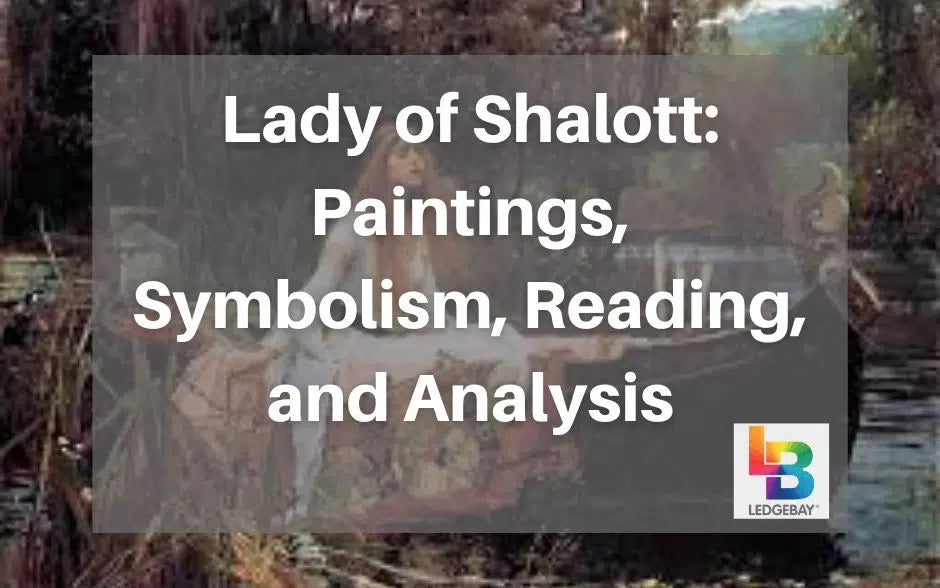The Lady of Shalott paintings is one of the most popular Arthurian characters. She is a beautiful woman who lives in a tower, and is forbidden to look outside.
One day, she sees Sir Lancelot riding by and falls in love with him. She breaks her curse and leaves her tower to follow him, but dies soon after. Her story has been told throughpaintings , poetry, and songs for centuries.
In this blog post, we will explore the symbolism and meaning behind this tragic figure.
JohnWilliam Waterhouse's subjects for painting from history, literature, and the past. In 1849, He was born in Rome, where his painter father worked. In his early childhood called "Nino" for the rest of his life. The family moved back to England in the 1850s.
Before Waterhouse went to school at the Royal Academy in 1870, he helped his father in his studio. Waterhouse's realistic painting abilities early works were shown at the Royal Academy national gallery,the Society of British Artists , and the Dudley Gallery. He went to Italy several times in the 1870s and 1880s. John William Waterhouse painted genre scenes.
Esther Kenworthy is the artist's wife. Esther, who was married to Waterhouse, and he did not have any children.
John William Waterhouse mostly painted with oils. He was accepted into the Royal Institute of Painters and left in 1889. John brought Consulting the Oracle to the Royal Academy in 1884, got good reviews, and Sir Henry Tate bought it. Tate also bought The Lady of Shalott at the Academy show in 1888.
The last painting shows Waterhouse's close attention to details. He was becoming more interested in popular subject in Pre-Raphaelites themes, especially tragic or powerful femme fatales, as well as painting in the open air. Some of hisfamous works and original paintings include Circe Invidiosa, Cleopatra, La Belle Dame Sans Merci, and several versions of Lamia are other paintings that show a femme fatale.

Although Waterhouse waspainting several decades after the Pre-Raphaelite Brotherhood split up when he was a child , this is one of his most well-known works because it adopts much of that group's style. In 1894, Sir Henry Tate gave The Lady of Shalott to the public. You can see it today in room 1840 atNational Gallery Tate Britain in London .


It is stated in the poem that the Lady of Shalott is confined to the island of Shalott and can only see the outer world through a mirror. She is stuck in a tower near King Arthur's Camelot because of an unknown curse.
The poet is based on Elaine of Astolat from the medieval Arthurian legend of unrequited love between a lady and knight Lancelot. According to Tennyson's poem despite being kept away from the outside world. The lady loves Sir Lancelot, but he doesn't love her back.
The Lady, who has a secret crush on the knight Sir Lancelot, can't help but stare at him when she sees him in the mirror. She immediately becomes the target of an undisclosed curse.
The young woman in Waterhouse's painting version of this literary tableau is shown looking away from the chain that holds the boat together and instead at a group of three candles, which represent the gravity of the situation.
The Pre-Raphaelite Brotherhood, a group of artists active in the mid-nineteenth century or during the pre raphaelite period, had a significant impact on John William Waterhouse's work and made this picture a staple of their Waterhouse's sketchbook canon.
Having broken the rules of her incarceration and attempted escape via the river, our heroine represents her final moments in Waterhouse's beautifully drawn picture. Tennyson describes her as having a trancelike appearance, with a "glassy countenance," which conveys a look of silent desperation.
"The Lady of Shalott" as a Symbol of Death: The poem tells the sad story of a woman who is locked up on an island. No one can see her except for the farmers who work in their fields and listen to her song. Everything around her is dark and without much color. She can't look out the window. She looks at the world outside through a mirror.
For her, reality is only what she sees when she looks in that mirror. The poem also goes into great detail about the place around her and how people move around in Camelot. One day, she sees a knight coming from the Barley Fields. He gets her attention, and she looks out the window and sees Camelot. As a punishment, she signs her last song, writes her name on the boat, and then dies.
Such artists shows by how well he pays attention to the rich detail and colors. With his pencil sketches he precisely painted detail of the beauty of nature, how realist he is, and how he shows a weak, longing woman.
[amazon box="B07HRF34NJ"]
Lancelot can come and go as he pleases, which is different from the Lady, who is stuck in her tower and can't do the same. In these ways, Shalott and Camelot show how men and women in Victorian society had different roles.
When the Lady finally leaves the tower, she goes back into the normal flow of life and time, which means she dies right away.
 The Lady's web and mirror are two of the most significant things in the poem. They show that she is both an artist and someone who has had strange things happen to her. Her web is a symbol of her art because she weaves pictures of what she sees in her mirror.
The Lady's web and mirror are two of the most significant things in the poem. They show that she is both an artist and someone who has had strange things happen to her. Her web is a symbol of her art because she weaves pictures of what she sees in her mirror.
This shows how distance is important for the growth of an artist's soul. The mirror lets her make reflections of the world without having to let outside influences mess up the purity of her art .
When the curse comes true and her weaving flies off the loom and her mirror breaks, it shows that her art was connected to her being alone. Now that she has given upart for real life , she is no longer in touch with her artistic spirit, and she can no longer weave.
Over the ship is an artifact which represents the tapestry of The Lady's imprisonment and presents scenes relating Tenney's text.

If you look closely, you can see a single leaf that has fallen on The Lady's lap. Her life is over; she is a leaf that has fallen and a woman who has also fallen.
[amazon box="B00E9P5X5E"]
Waterhouse, whose style and subject matter were influenced by the Pre-Raphaelites, also liked the poem a lot. The Lady of Shalott became one of the artist's mostfamous works , and he painted two more versions of the character: The Lady of Shalott Looking at Lancelot (1894) and I am Half-Sick of Shadows, said the Lady of Shalott (1896).

One day, she sees Sir Lancelot riding by and falls in love with him. She breaks her curse and leaves her tower to follow him, but dies soon after. Her story has been told throughpaintings , poetry, and songs for centuries.
In this blog post, we will explore the symbolism and meaning behind this tragic figure.
Who Is John William Waterhouse?

JohnWilliam Waterhouse's subjects for painting from history, literature, and the past. In 1849, He was born in Rome, where his painter father worked. In his early childhood called "Nino" for the rest of his life. The family moved back to England in the 1850s.
Before Waterhouse went to school at the Royal Academy in 1870, he helped his father in his studio. Waterhouse's realistic painting abilities early works were shown at the Royal Academy national gallery,the Society of British Artists , and the Dudley Gallery. He went to Italy several times in the 1870s and 1880s. John William Waterhouse painted genre scenes.
Esther Kenworthy is the artist's wife. Esther, who was married to Waterhouse, and he did not have any children.
John William Waterhouse Artistic Skill
[amazon box="B07D2JN5S1"]John William Waterhouse mostly painted with oils. He was accepted into the Royal Institute of Painters and left in 1889. John brought Consulting the Oracle to the Royal Academy in 1884, got good reviews, and Sir Henry Tate bought it. Tate also bought The Lady of Shalott at the Academy show in 1888.
The last painting shows Waterhouse's close attention to details. He was becoming more interested in popular subject in Pre-Raphaelites themes, especially tragic or powerful femme fatales, as well as painting in the open air. Some of hisfamous works and original paintings include Circe Invidiosa, Cleopatra, La Belle Dame Sans Merci, and several versions of Lamia are other paintings that show a femme fatale.

John William Waterhouse Lady Of Shallot Painting
John William Waterhouse is an English painter. He created "The Lady of Shalott" in 1888. It depicts the final lines of the poem by the same name written by Alfred, Lord Tennyson in 1832. Waterhouse shows this persona in three paces paintings between the years 1888 and 1915.Although Waterhouse waspainting several decades after the Pre-Raphaelite Brotherhood split up when he was a child , this is one of his most well-known works because it adopts much of that group's style. In 1894, Sir Henry Tate gave The Lady of Shalott to the public. You can see it today in room 1840 atNational Gallery Tate Britain in London .
Lady Of Shallot Painting Is Based In Sir Henry Tate's Poem
This Tennyson's poem Originally published in 1832. The poet describes the story of a cursed woman trapped in a tower who makes a futile attempt to escape, ensuring her own death.
Lifted From Part IV of Tennyson's Poem:
And down the river's dim expanse
Like some bold seer in a trance,
Seeing all his own mischance
With glassy countenance
Did she look at Camelot.
And at the closing of the day
She loosed the chain, and down she lay;
The broad stream bore her far away,
The Lady of Shalott
With a steady stony glance–
Like some bold seer in a trance,
Beholding all his own mischance,
Mute, with a glassy countenance–
She look’d down to Camelot.
It was the closing of the day
She loosed the chain, and down she lay;
The broad stream bore her far away,
The Lady of Shalott.
Story Behind Lady Of Shallot Painting

It is stated in the poem that the Lady of Shalott is confined to the island of Shalott and can only see the outer world through a mirror. She is stuck in a tower near King Arthur's Camelot because of an unknown curse.
The poet is based on Elaine of Astolat from the medieval Arthurian legend of unrequited love between a lady and knight Lancelot. According to Tennyson's poem despite being kept away from the outside world. The lady loves Sir Lancelot, but he doesn't love her back.
The Lady, who has a secret crush on the knight Sir Lancelot, can't help but stare at him when she sees him in the mirror. She immediately becomes the target of an undisclosed curse.
The young woman in Waterhouse's painting version of this literary tableau is shown looking away from the chain that holds the boat together and instead at a group of three candles, which represent the gravity of the situation.
The Pre-Raphaelite Brotherhood, a group of artists active in the mid-nineteenth century or during the pre raphaelite period, had a significant impact on John William Waterhouse's work and made this picture a staple of their Waterhouse's sketchbook canon.
Having broken the rules of her incarceration and attempted escape via the river, our heroine represents her final moments in Waterhouse's beautifully drawn picture. Tennyson describes her as having a trancelike appearance, with a "glassy countenance," which conveys a look of silent desperation.
What Is The Message Of The Lady Of Shalott Painting?

"The Lady of Shalott" as a Symbol of Death: The poem tells the sad story of a woman who is locked up on an island. No one can see her except for the farmers who work in their fields and listen to her song. Everything around her is dark and without much color. She can't look out the window. She looks at the world outside through a mirror.
For her, reality is only what she sees when she looks in that mirror. The poem also goes into great detail about the place around her and how people move around in Camelot. One day, she sees a knight coming from the Barley Fields. He gets her attention, and she looks out the window and sees Camelot. As a punishment, she signs her last song, writes her name on the boat, and then dies.
Symbols for Tennyson's Poem
Candles stood for life, and the fact that two of them are already out shows that she is going to die soon. Aside from the symbolic parts, this painting is valued for its realistic quality. Waterhouse painted it. The background has amuch darker hues than her stark white dress.Such artists shows by how well he pays attention to the rich detail and colors. With his pencil sketches he precisely painted detail of the beauty of nature, how realist he is, and how he shows a weak, longing woman.
[amazon box="B07HRF34NJ"]
Camelot:
The repeated refrains of "Camelot" and "Shalott" help to put the two places in the center and show that they are symbols of opposite things. In the first part, Camelot is described as a busy place where people can come and go as they please.Shalott:
Shalott, on the other hand, is a "silent island" where a single woman lives in a tower and no one knows about it. The Lady is tied to Shalott in a way that can't be broken, and Tennyson only gives us her title. Lancelot has something to do with Camelot because he is an Arthurian knight and is going there.Lancelot can come and go as he pleases, which is different from the Lady, who is stuck in her tower and can't do the same. In these ways, Shalott and Camelot show how men and women in Victorian society had different roles.
The River:
The river is a big part of the poem, and it shows how life flows. People go to and from Camelot on boats that run along the river next to the tower at Shalott. It makes it easier for people to move around and talk to each other as they go about their lives, which is different from the Lady, who stays still in her tower.When the Lady finally leaves the tower, she goes back into the normal flow of life and time, which means she dies right away.
The Lady's Web and Mirror
 The Lady's web and mirror are two of the most significant things in the poem. They show that she is both an artist and someone who has had strange things happen to her. Her web is a symbol of her art because she weaves pictures of what she sees in her mirror.
The Lady's web and mirror are two of the most significant things in the poem. They show that she is both an artist and someone who has had strange things happen to her. Her web is a symbol of her art because she weaves pictures of what she sees in her mirror.This shows how distance is important for the growth of an artist's soul. The mirror lets her make reflections of the world without having to let outside influences mess up the purity of her art .
When the curse comes true and her weaving flies off the loom and her mirror breaks, it shows that her art was connected to her being alone. Now that she has given upart for real life , she is no longer in touch with her artistic spirit, and she can no longer weave.
The Small Boat and the Chain
The boat's chain is a symbol of how she is oppressed and locked up from the outside world, and when she takes it off, she seals her fate.Over the ship is an artifact which represents the tapestry of The Lady's imprisonment and presents scenes relating Tenney's text.
Tapestry
A tapestry, represents the one the lady wove while she was in jail. Furthermore, the picture above shows the scene from Tennyson's poem. It is a draped over the boat.
Candles
Three candles, which symbolise life, are at the end of the boat. Two of the candles are out, which means death is coming soon. Along with these are a crucifix and a rosary, which are symbols of death and sacrifice.If you look closely, you can see a single leaf that has fallen on The Lady's lap. Her life is over; she is a leaf that has fallen and a woman who has also fallen.
[amazon box="B00E9P5X5E"]
What Are Other Tennyson's Collected Works?
Tennyson's poem was very popular with Pre-Raphaelite painters and poets. It inspired many works, such as The Lady of Shalott (1878) by John Atkinson Grimshaw, The Lady of Shalott (1857) by Dante Gabriel Rossetti, and The Lady of Shalott (1905) by William Holman Hunt.Waterhouse, whose style and subject matter were influenced by the Pre-Raphaelites, also liked the poem a lot. The Lady of Shalott became one of the artist's mostfamous works , and he painted two more versions of the character: The Lady of Shalott Looking at Lancelot (1894) and I am Half-Sick of Shadows, said the Lady of Shalott (1896).
Frequently Asked Questions:
What Does The Poem "The Lady Of Shalott" Have As Its Main Idea?
Indeed this poem's main themes are isolation, detachment, and the supernatural. Also, she is physically and emotionally cut off from the real world. And she accepts it as her fate.











